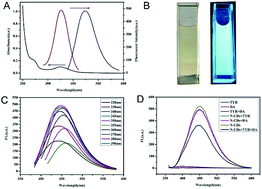Fluorescence sensing of tyrosinase activity based on amine rich carbon dots through direct interaction in a homogeneous system: detection mechanism and application†
Abstract
As a vital, copper-containing oxidase, tyrosinase (TYR) is useful as a biomarker for the screening of skin diseases. In this paper, a convenient and sensitive homogeneous fluorescence detection platform for the assay of TYR activity without any modified steps is described. Inspired by the fact that carbon dots (CDs) with excellent properties can be obtained through some surface modification, amine rich carbon dots (N-CDs) using a nitrogen doping process were developed as the fluorescent probe for this assay. The effect and the response mechanism of the degree of nitrogen doping in relation to the response of different CDs to the sensing of TYR activity using dopamine (DA) as a substrate were investigated. The DA was oxidized to o-dopaquinone with the catalyzation of TYR and quenched the fluorescence of the N-CDs by direct interaction. By using a set concentration of DA and other optimized reaction conditions, the fluorescence intensity of the N-CDs was directly applied to monitor the TYR activity. This assay for TYR activity showed a broad linear range from 0.05 to 6.0 U mL−1 with a detection limit of 0.039 U mL−1. The satisfactory recovery of the sensor for TYR activity in diluted human serum illustrated a potential clinical application.



 Please wait while we load your content...
Please wait while we load your content...